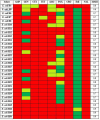Molecular Characterization of Plasmid-Mediated Quinolone Resistance Genes in Multidrug-Resistant Escherichia coli Isolated From Wastewater Generated From the Hospital Environment
- PMID: 40552214
- PMCID: PMC12183395
- DOI: 10.1177/11786302251342936
Molecular Characterization of Plasmid-Mediated Quinolone Resistance Genes in Multidrug-Resistant Escherichia coli Isolated From Wastewater Generated From the Hospital Environment
Abstract
Aim: This study investigated the carriage of Plasmid-Mediated Quinolone Resistance (PMQR) genes in fluoroquinolone-resistant Escherichia coli recovered from wastewater generated by healthcare institutions.
Materials and methods: Isolation of fluoroquinolone-resistant Escherichia coli was done on medium supplemented with 1 µg/mL of ciprofloxacin (a fluoroquinolone). Presumptive isolates were identified via the detection of uidA gene. Susceptibility of the isolates to a panel of antibiotics was done using disc diffusion method. Detection of PMQR genes in the isolates was done using primer-specific PCR.
Results: Thirty fluoroquinolone-resistant Escherichia coli were obtained from the wastewater over a period of 6 months. The resistance to each of the antibiotic tested was: ampicillin (100%), ceftriaxone (100%), nalidixic acid (100%), tetracycline (96.7%), cefotaxime (96.7%), amoxicillin-clavulanate (80%), gentamicin (60%), cefoxitin (30%), and imipenem (3.3%). The Multiple Antibiotic Resistance Index (MARI) ranged from 0.6 to 0.9. The detection of PMQR genes in the 30 isolates was: qnrA (76.7%), qnrB (53.3%), qnrS (63.3%), aac(6')-lb-cr (43.3%), and qepA (43.3%). All the fluoroquinolone-resistant Escherichia coli carried at least one PMQR determinant.
Conclusion: This study revealed that untreated hospital wastewaters are significant hub of multidrug-resistant and fluoroquinolone-resistant Escherichia coli, showing high carriage of PMQR genes, and may be a major contributor to the resistome of fluoroquinolone-resistant bacteria in the Nigerian environment.
Keywords: Fluoroquinolone-resistant Escherichia coli; Multiple Antibiotic Resistance Index (MARI); Plasmid-Mediated Quinolone Resistance (PMQR); antibiotic resistance; healthcare settings.
Plain language summary
Escherichia coli showing resistance ciprofloxacin, a fluoroquinolone antibiotic was isolated from wastewater of some selected healthcare institutions in South-west Nigeria. The bacteria were identified using the detection of uidA gene, and they were tested against some antibiotics using the disc diffusion test. The detection of PMQR genes was done using primer-specific PCR. A total of 30 fluoroquinolone-resistant isolates were recovered from the wastewater in six months. All the isolates were resistant to ampicillin and nalidixic acid, while the least level of resistance was to imipenem, a carbapenem antibiotic. The multiple antibiotic resistance index for the isolates ranged from 0.6 to 0.9. All the isolates were multidrug-resistant. The frequency of PMQR genes in the 30 resistant isolates obtained from the wastewater was: qnrA (76.7%), qnrS (60%), qnrB (53%), aac(6')-lb-cr (43.3%) and qepA (40%). All the isolates carried at least one of the target PMQR genes. Wastewater from healthcare institution is a breeding ground for fluoroquinolone-resistant Escherichia coli.
© The Author(s) 2025.
Conflict of interest statement
The author(s) declared no potential conflicts of interest with respect to the research, authorship, and/or publication of this article.
Figures



Similar articles
-
Resistance Profiling of Predominant Non-E. coli Enterobacteriaceae Isolated From Humans, Food Animals, and the Environment in the Fako Division of Cameroon.Biomed Res Int. 2025 Jun 23;2025:3947539. doi: 10.1155/bmri/3947539. eCollection 2025. Biomed Res Int. 2025. PMID: 40589603 Free PMC article.
-
Coexistence of PMQR and ESBL genes among clinical Escherichia coli isolates from community-acquired UTI in Mexicali, on the US-Mexico border.Braz J Infect Dis. 2025 Jul-Aug;29(4):104554. doi: 10.1016/j.bjid.2025.104554. Epub 2025 May 23. Braz J Infect Dis. 2025. PMID: 40412027 Free PMC article.
-
Pan-drug, colistin, streptomycin, erythromycin, clindamycin resistant Salmonella enterica serovars isolated from slaughtered cattle and human in mansoura, Egypt.Ann Clin Microbiol Antimicrob. 2025 Jul 3;24(1):40. doi: 10.1186/s12941-025-00809-4. Ann Clin Microbiol Antimicrob. 2025. PMID: 40611300 Free PMC article.
-
Prophylactic antibiotics for adults with chronic obstructive pulmonary disease: a network meta-analysis.Cochrane Database Syst Rev. 2021 Jan 15;1(1):CD013198. doi: 10.1002/14651858.CD013198.pub2. Cochrane Database Syst Rev. 2021. PMID: 33448349 Free PMC article.
-
Xpert MTB/XDR for detection of pulmonary tuberculosis and resistance to isoniazid, fluoroquinolones, ethionamide, and amikacin.Cochrane Database Syst Rev. 2022 May 18;5(5):CD014841. doi: 10.1002/14651858.CD014841.pub2. Cochrane Database Syst Rev. 2022. PMID: 35583175 Free PMC article.
References
-
- Aminul P, Anwar S, Molla MMA, Miah MRA. Evaluation of antibiotic resistance patterns in clinical isolates of Klebsiella pneumoniae in Bangladesh. Biosaf Heal. 2021;3:301-306.
LinkOut - more resources
Full Text Sources

